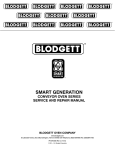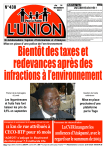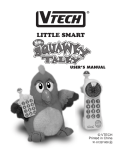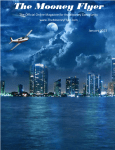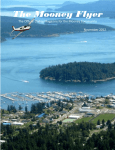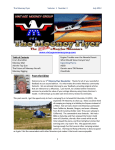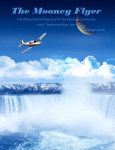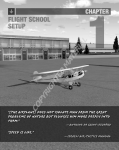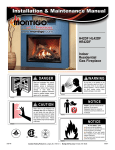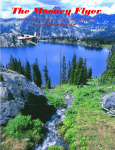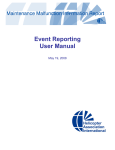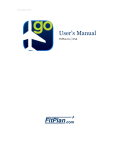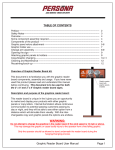Download December, 2012 - The Mooney Flyer
Transcript
The Mooney Flyer Volume 1 Number 8 December 2012 The Mooney Flyer The Official Online Magazine for the Mooney Community www.TheMooneyFlyer.com December 2012 1 Back to Table of Contents The Mooney Flyer Volume 1 Number 8 December 2012 Contents Features Exchanging Elbow Grease for Speed Bob Kromer explains how applying the Results of Factory Laminar Flow Flight Testing Can Make Your Mooney Faster Buying a Mooney – Part 2, The Medium Body Mooneys (F-K) This month we cover the Mid-Body Mooneys to help in selecting your Mooney Why Does 100LL Cost so Much Editors Phil Corman Jim Price Contributing Writers Bob Kromer Tom Rouch Paul Loewen Linda Corman To Subscribe Click Here To Advertise Click Here To Submit an Article Click Here Jim explains how 100LL is refined and why it costs so much The Scary Holding Pattern Here’s an article submitted by reader G. Lee regarding entries to Holding Patterns Memory Jogger – Class A-D Airspace review Just in case you didn’t know it all, Jim reviews what you need to know Getting Along with ATC Correct Phraseology when talking with ATC Mooney Tales Right Seater Linda Corman takes you to beautiful Lake Powell In Every Issue From the Editor Appraise Your Mooney’s Value Website of the Month Mooney Mail Bag Ask the Top Gun – Tom Rouch answers your questions Upcoming Fly-Ins – Have You Heard the News? – Relevant GA news & links for the month Product Review – The iPad Mini was released last month... here’s what Mooney pilots want and need to know Classifieds Click Here to Subscribe 2 Click Here For Back Issues Back to Table of Contents The Mooney Flyer Volume 1 Number 8 December 2012 This issue marks the end of our first calendar year of publishing The Mooney Flyer. Our reader base has grown exponentially month over month. We’d like to thank everyone sending such wonderful supportive emails to us. It makes the entire effort worthwhile. This month we also introduced two additional online sites. The first is The Mooney Flyer website, www.TheMooneyFlyer.com. It is just a start, but we intend it to be the hub of all useful and entertaining Mooney-related information. Currently, it has links to all our past issues, all Mooney Service Instructions & Bulletins, Vintage Mooney Valuations, Upcoming Fly-ins across the country, a Forum link, and more. We also added a Facebook page. You can access that page on Facebook by searching for The Mooney Flyer or clicking on this link: https://www.facebook.com/TheMooneyFlyer. This is just one more place to interact with the Flyer. And just in time for your holiday shopping, we have 3 pages of coupons from LASAR (Lake Aero Styling & Repair). Click Here to review all of these fabulous deals from one of the best in the West (MSCs that is) Appraise Your Mooney’s Value Don’t forget about our cool new Appraise your Mooney’s Value using Jimmy Garrision’s valuation. Jimmy is from All American Aircraft, the country’s largest Mooney reseller. We have implemented the models for M20C, M20E, M20G, M20F & M20J. Click on your model and simply complete the valuation. You no longer need paper and pencil. Just another benefit to our subscribers. These forms are currently Beta test quality. Please send errors to us. M20C M20E M20G M20F M20J 3 Back to Table of Contents The Mooney Flyer Volume 1 Number 8 December 2012 www.TheMooneyFlyer.com We shamelessly introduce The Mooney Flyer website this month to complement our eMagazine. Here you can find everything Mooney Flyer including an Archive of all back issues. We are excited about this as we close our first calendar year of publishing The Mooney Flyer. In the future, we plan to add more features to the website, but for now you can find all kinds of useful links including our eMagazine, Valuations for all vintage Mooneys, a Mooney Cost of Ownership spreadsheet, Upcoming Mooney events, Mooney Service Bulletins & Service Instructions and even a link to the MooneySpace forum. In addition, we have a button for readers to submit articles for inclusion in upcoming issues. Check it out! I’m always curious to know where the planes are in the world. While browsing the web, I came across this graphic. I thought I would share it with you. Notably missing is China, having been in the news so often lately. But I’m betting that China will grow their GA population significantly and will be on this map over the next 10 years. 4 Back to Table of Contents The Mooney Flyer Volume 1 Number 8 December 2012 Mooney Mail Bag As a 40 yrs. owner of an F model, and since 1981 K model, I was very pleased to receive your Mooney Flyer e-mail edition. The articles are right on, and I can relate to them, especially the cable brake. I was a little luckier. My throttle cable froze (literally) at FL 17. My experience with the Mooney has been a great for 6K hrs and 6 engine failures over the years. I would like to be a part of your readership. Larry Tain N231AL Great publication! Very interesting stories. You definitely outshine the MAPA Log which is the most boring publications around. What are your plans and aspirations? In any case, Good luck. Best Wishes, Jonathan The Flyer is a fantastic piece of informative journalism. As the editor of the Australian Mooney Pilots Association newsletter, I give it 10/10! Cheers, Tony Rees, Perth, Western Australia, M20J VH-MIP I love this magazine! It keeps getting better with every issue! Hank, 1970 M20C A Review of Flight Reviews -- I'd like to address the section of this article dealing with logging time. That section states, "You don’t need a current medical to have an annual review, but if your medical has expired, you’ll log the Flight Review time as “dual”. Once you get a medical, you can then fly as PIC. If you have a current medical, then log the time as PIC." This is incorrect. The Flight review time should always be logged (and signed by the instructor) as dual, and can also be logged as PIC time. Neither of these depend on whether the pilot has a current medical or flight review. As noted by the article, FAR 61.56(a) requires that a flight review include at least one hour of flight training. FAR 61.189(a) requires that a CFI "sign the logbook of each person to whom that instructor has given flight training or ground training". This requirement is distinct from the requirement for an endorsement for a successfully-completed flight review. Thus, whether or not the pilot is currently legal to be PIC, the pilot needs to log the flight (and ground) training received, and the CFI needs to sign the entry. Under FAR 61.56(c)(1), a flight review is only valid if it's given in an aircraft for which the pilot is rated. Generally, the pilot's going to be at the controls for any of the flying during a flight review (with perhaps a few moments of exception, such as the CFI putting the plane into an unusual attitude). Therefore, under FAR 61.51(e)(1)(i), the pilot can log the time as PIC time, irrespective of whether the pilot can legally act as PIC (medical, flight review, HP/complex endorsement, etc.). This section requires only that the pilot be the sole manipulator of the controls (i.e., the pilot flying) of an aircraft for which he is rated (i.e., ASEL or whatever). In summary: Any pilot receiving a flight review should log the time both as "dual received" and as PIC, regardless of whether he's legal to be PIC at the time of the flight review. Dan Brown, KE6MKS Regarding M20C Mark 21s -- In the most recent edition of The Mooney Flyer, it states, " The Ranger has essentially the same specs as the Mark 21. In the interest of speed, the entrance step retracted during flight." I have a 1962 M20 C Mark 21. The step operates via a manual crank adjacent to the pilot's left knee. This is contrary to what was pasted above. 5 Back to Table of Contents The Mooney Flyer Volume 1 Number 8 December 2012 Also, you state that the manual gear is hard to operate. Sure, this is subjective, but I have zero problems operating it. Just pick up the gear before the Mooney gets going too fast and it's a piece of cake. I usually retract at 80 MIAS or below. Try to retract the gear at 110 MIAS, and you'll have a hard time. As far as extending the gear, it's super easy. Get the plane below 120 MIAS, unhook the J-bar, and watch the gear drop itself. A tiny little bit of push is needed on the J-bar to get it seated in the latch for locked down position, but a 90 lb woman could do it. Brian Boe Editor’s Note: Brian is correct. There were manual cranks. When they came up with the PC system, they used vacuum power to retract the step. Another SUPERB issue! Thank you guys for putting so much good info out there for the rest of us. Ivan I can't give you a bigger WOW! than I have before, but really how about WOW, WOW! Both Paul and I are amazed at all you are doing with the Flyer. GREAT job! Paul & Shery Loewen The LOG is only a distant second. Take a look at the current edition of each. There is no comparison. Michael Armstead Mooney Hurricane Story -- Your Mooney Flyer is great and I would have to say better then the MAPA magazine which is the same old thing every month. Here’s a quick Mooney M20R Ovation story. On Saturday Oct. 27th I had to make a decision to fly out of the Philly area to the Bahamas to avoid Hurricane Sandy or sit it out for a week. A big high pressure was to my West and Sandy to my East with a descend opening in between. With the clockwise rotation of the High combined with the counter Clockwise rotation of Hurricane Sandy I found myself cruising along at 244 knots at 6,000' and in smooth air. What fun flying with that kind of a tail wind, picture below taken with my iPad on my Garmin GNS750 GPS. Blue Skies, Lloyd Great issue (as usual). Good article on the TFR violation, but you can operate VFR in the outer ring. However, you MUST be on an active flight plan, squawking your assigned code, and in direct two-way comm with ATC. VFR pilots are not grounded, you can get in/out of airports w/in the outer ring BUT you better be filed, talkin', and squawkin'! Here is the verbiage from those pesky VIP TFRs: "B. For operations within the airspace between the 10 nmr and 30 nmr area(s) listed above, known as the outer ring(s): All aircraft operating within the outer ring(s) listed above are limited to aircraft arriving or departing local airfields, and workload permitting, ATC may authorize transit operations. Aircraft may not loiter. All aircraft must be on an active IFR or VFR flight plan with a discrete code assigned by an air traffic control (ATC) facility. Aircraft must be squawking the discrete code prior to departure and at all times while in the TFR and must remain in two-way radio communications with ATC." Also no hangin' out in the outer ring in order to do anything useful (like flight training): "C. THE FOLLOWING OPERATIONS ARE NOT AUTHORIZED WITHIN THIS TFR: FLIGHT TRAINING, PRACTICE INSTRUMENT APPROACHES, AEROBATIC FLIGHT, GLIDER OPERATIONS, SEAPLANE OPERATIONS, PARACHUTE OPERATIONS, ULTRALIGHT, HANG GLIDING, BALLOON OPERATIONS, AGRICULTURE/CROP DUSTING, ANIMAL POPULATION CONTROL FLIGHT OPERATIONS, BANNER TOWING OPERATIONS, SIGHTSEEING OPERATIONS, MAINTENANCE TEST FLIGHTS, RADIO CONTROLLED MODEL AIRCRAFT 6 Back to Table of Contents The Mooney Flyer Volume 1 Number 8 December 2012 OPERATIONS, MODEL ROCKETRY, UNMANNED AIRCRAFT SYSTEMS (UAS), AND UTILITY AND PIPELINE SURVEY OPERATIONS." Great to hear that the feds were very reasonable with our fellow Mooney driver Dave Marten Great magazine! I have referred others. It's very informative, fun to read, and well done. Thanks for all you do. Best regards, Terry Hart Mooney Flare Art 7 Back to Table of Contents The Mooney Flyer Volume 1 Number 8 December 2012 Exchanging Elbow Grease for Airspeed Applying the Results of Factory Laminar Flow Flight Testing Can Make Your Mooney Faster By Bob Kromer Mooney Factory Engineering Test Pilot 1983-1986 Mooney Executive VP and GM 1986-1991 In 1984, the engineering flight test department at the Mooney factory conducted a test program investigating laminar flow characteristics of the Mooney airfoil section and wing. A new production M20K 231 with unpainted wings was used for this testing. Due to similarities in wing design and airfoil sections used on all Mooneys, what we learned from this testing could be one of the least expensive speed mods for your airplane, regardless of which model you fly. This laminar flow research program was partially funded by NASA, back in the day when they had interest in General Aviation airplanes. Mooneys, famous for low aerodynamic drag characteristics, were an excellent choice for this program. Additionally, Mooney’s flight test department was quite good at measuring the performance effects of various speed mods on cruise drag/speed. This is termed “speed/power” testing and requires a high level of precision flying for accuracy. But good flying technique along with the use of a calibrated airspeed boom, sensitive airspeed indicator and an engine torque meter resulted in data precise enough to be able to detect speed changes from one configuration to another within a couple of knots. This test program consisted of a number of flights with various levels of wing surface “smoothness”. Testing began with intentional surface roughness applied to the upper, lower and leading edge wing surfaces. Wing surface smoothness was gradually increased with polish and wax. The last condition tested was achieved by smoothly painting and heavily waxing the wing surfaces to make them as smooth as possible. I remember the final wing surface configuration tested on the metal-winged M20K test airplane looking almost as smooth as one made of composites. In addition to measuring level flight airspeed (drag) for each wing surface condition, we were also able to visually differentiate laminar and turbulent flow on the upper wing surface. Prior to each test flight, a sprayable fluid called Spraylat was applied to the upper and lower wing surfaces in a very thin layer, drying to a fine layer of material resembling sticky talcum powder. After flying for 30 minutes or so, any turbulent (non-laminar, higher drag) flow areas on the wing surface would remove the Spraylat material, making visible the bare metal surface of the wing. On those areas of the wing where the airflow was laminar (lower drag), the white Spraylat material would remain. Thus, after returning from a 30 minute 8 Back to Table of Contents The Mooney Flyer Volume 1 Number 8 December 2012 flight, the wing surfaces would show white areas (denoting laminar) and shiny metal areas (denoting turbulent). Armed with several cans of Spraylat, we conducted a number of flights to discover if wing smoothness had an effect on encouraging lower drag laminar flow over more of the wing’s surfaces. The results we discovered seem simple and obvious. But if applied to your airplane, these test results can make your airplane faster and more efficient. Testing revealed the Mooney wing can be made to maintain much desired laminar flow on a significant portion of both the upper and lower surfaces. In fact, lower drag laminar flow can be maintained from the leading edge aft to almost the main spar location (about 35-40% of the cord). But to do so, the leading edges of the wing as well as the upper and lower wing surfaces from the leading edges back to the main spar location must be kept smoothly painted, heavily waxed and as bug free as possible. On the test airplane, it was interesting to see the desired laminar flow tripped by something as small as a bug strike on the leading edge, or a protruding screw head on an inspection panel forward of the main spar. Behind the bug strike or the screw head, the flow would be tripped to turbulent (non-laminar), causing a shiny triangular region in the Spraylat material aft of the protrusion. These shiny areas meant turbulent, non-laminar flow, higher drag and a tiny loss of speed. When added together, these individual areas of unwanted non-laminar flow were enough to be measured. So what is keeping the upper and lower wing surfaces and leading edges painted, waxed, smooth and slippery worth in speed gain? It is measurable. A wing with a nice smooth paint and wax job from the leading edges back to the main spar on both the upper and lower surfaces resulted in 2-3KTS of extra true airspeed compared to a dirty, rough, unpainted and unwaxed wing. This due to the smoother wing surface conditions forward of the main spar enabling the Mooney wing to maintain lower drag laminar flow further aft from the wing leading edges in these regions. Interestingly, waxing the wing surfaces aft of the main spar might look good, but did nothing for performance. Spralyat patterns always showed the airflow tripped from laminar to turbulent (nonlaminar) by the time the airflow reached as far aft as the main spar location. Nothing could be done to keep the surface airflow laminar aft of the main spar. So it’s true - a little elbow grease can result in a measurable performance gain for your Mooney. While 2-3KTS true airspeed might not sound like much, over a year of flying it can be measured in a little less fuel used. Plus, we Mooney pilots tend to be rather fanatical about efficiency, economy and speed. So get out the rags, use a high quality wax and polish those wings from the leading edges back to the main spar on both the upper and lower surfaces. Keep the bugs off the leading edges. Make sure the screws in the inspection panels are nice and flush. Exchange some elbow grease and some attention to wing surface smoothness for some free airspeed. And put a little money in the bank. 9 Back to Table of Contents The Mooney Flyer Volume 1 Number 8 December 2012 So You Want to Buy a Mooney! Here’s What You Want to Know Part 2: The Medium Bodies Last month we began this three part series by covering the Short Body Mooneys (M20A through M20E). This month we will review the Medium Body Mooneys, models M20F, M20 G, M20J, and M20K. Many current and past Mooney owners will argue that the J and the K were Mooney’s masterpieces. We don’t disagree. To begin with, here is a snapshot summary of the performance of these 3 Mooneys. M20F Executive The M20F, the next step up from the short body M20E offers more cabin space. They have the same engine, same aerodynamics, and same wing, but the F has 10 additional inches of leg room. This makes life for your rear seat passengers noticeably improved. The longer fuselage also tends to damp out yawing motion in rough air. The second major improvement is that the F carries 64 gallons of fuel, 12 more than the E which translates into longer range. You can flight plan easily for 4 ½ hours with proper reserve. The third major difference from E to F is The Gross Weight. On the F is 2740 lbs - the E model is 2575 lbs. If you are looking at an F, remember that the 1967 Executives are the fastest; from 1968 on, Mooney stopped some of the flush riveting on the wings and those models are 5-6 mph slower than the '67 M20F. The F handles much the same as a C or E. However, an F isn't always an F. In 1970, it became the 220 Executive and then the 220 Aerostar under a different company owner. Also, the Mooneys of that period were fitted with bulbous "stinger" tailcones and matching protuberances from the top of the rudder to give the airplane a more distinct shape. Lake Aero Styling and Repair owner Paul Loewen has a 10 Back to Table of Contents The Mooney Flyer Volume 1 Number 8 December 2012 real love affair with these stingers. He's made them into a retrofit kit for all Mooneys, and his own personal 201 has been so equipped. M20G Stateman The long-fuselage, 180-hp engine Mooney is the Statesman, and it is even slower, though it has all the room of the Executive. Because of the length, empty weight is higher than the short-body 180s, so the Statesman doesn't carry as much or go as fast, either. For basic transportation, though, it can be a good buy as it tends to be undervalued by the performance conscious Mooney buyers. For about the same money, an Executive is better. M20J “201” The M20J, also referred to as the “201” is arguably the sweetest design from Mooney. It has the same body and wing as the F, but boy oh boy is it faster. So how did the 201 exceed the coveted 200 mph mark with the same power plant and fuselage as the much slower M20F? It all comes down to drag reduction. Mooney engineers had seen the potential for aerodynamic improvements of the M20F, but it wasn’t until Roy LoPresti joined the company in 1973 that the ball got rolling. Several key modifications contributed to the increase in speed. The engine cowl redesign added about 8 mph, the sloped windshield also added about 8 mph, the inboard gear doors added about 5 mph, and the gap seals, flap hinge and empennage fairings added another 1 mph compared with the M20F. Another benefit of the M20J over its predecessors is the panel configuration. The 201 panel accommodates the now-standard six-pack configuration, which is a huge safety improvement over earlier models for IFR pilots. Just imagine flying hard IFR with the primary flight instruments scattered randomly in a nonrectangular pattern. Engine cooling in the J is substantially better than all previous models. This could be a factor in hot climates. With 1989 came the curved window option for the J. Another significant change is that Gross Weight was improved by 160 lbs to 2900 lbs. 11 Back to Table of Contents The Mooney Flyer Volume 1 Number 8 December 2012 M20K “231”, “252” and Encore We reviewed the M20K extensively last month, so we recommend that you refer to that article for more details. This is Mooney’s first non-pressurized turbo with a Continental TSIO 360 GB Engine. A later Continental was introduced, the “LB”, which is more reliable than the GB. The first model was the “231”. I n 1986, Mooney added an intercooler, hydraulically controlled wastegate and controller, more effective oil cooler and other changes internal to the engine. The model M20K is the “252”. The 252 was produced again in 1997 as the M20K Encore, which resulted in another 10 hp and more useful load. It’s important to know that TBO for the 231 is 1800 hrs which is 200 less than most engines. Premature cylinder wear on the GB and LB are a consideration for owners. The MB variant is much improved. As you can see, the medium body M20 provides an additional 10” of cabin legroom and arguably the best Price/Performance costs in the entire M20 fleet. The J and K are simply hard to beat if you want to go fast and fly cheaper. Click on the picture to see this amazing Miniature Airport in motion 12 Back to Table of Contents The Mooney Flyer Volume 1 Number 8 December 2012 Send your questions for Tom to [email protected] What items should be checked on a Mooney if you fly over 100 hrs between Annuals? A very good question and the one most abused. I will break it done in two sections. Mandatory: There are a number of Ads on different Mooney models that are very specific in being required every 100 hours. They are usually required is every 100 hrs or at a minimum, each Annual. Every owner is required to maintain a list of recurring ADs. I will list the most common that apply to some models of Mooneys. AD 73-21-01, Flt Control and Gear Lube AD 76-07-12, Bendix ignition switch check. AD 75-23-04, 100/200 hour Gear Actuator lube and gear inspection. AD 75-09-08, Engine mount inspection (until mount modified) AD 11-26-04, Lycoming injector line clamp inspection. There can be more recurring ADs, depending on what modifications may have been done to your plane. I see quite a few planes come in for Annual that have flown over 100 hours in the year and none of these ADs are done. AS an IA, these items are law to me and you all can discuss the merits of each but until rescinded, they are required. The only one on the list above that applies to the long bodies, is the Lycoming AD on injected engines. RECOMMENDED: The Mooney Service manuals list 25, 50 and 100 hour inspections. The 100 hour is 100/Annual as it is the same checklist. Almost no one does all these inspections and I believe they are “overkill” although it sure would help my business. What I do recommend is doing the engine 100 hour and the airframe 50 hour if you are flying a lot over 100 hrs per year. As a minimum, I suggest at least a mag timing check, sparkplug cleaning, a compression check, a good look over of the engine and exhaust for damage. As for the airframe, check brakes for wear, batteries for service need, and lube the gear and flight controls. There are quite a few service bulletins, none of which are mandatory, but I recommend a few, and they are mostly on the magnetos. Both Bendix and Slick recommend 500 hr inspections and also, there are separate inspections for pressurized mags. I also recommend the valve wobble test on Lycoming’s SB 388. Just two months ago we had to repair a broken Bendix mag, about 600 total on an airplane that had stripped about 12 teeth off the distributer gear. This was a pressurized magneto on a TSIO 550. I 13 Back to Table of Contents The Mooney Flyer Volume 1 Number 8 December 2012 find problems are more prevalent on both Slick and Bendix pressurized magnetos because of the hot air used to pressurize. .While an inspection may not have revealed the gear problem, anything you can do to keep the mags in top shape I recommend. When should I replace the shock discs and how long do they last. There are three things we check at Annual. Before we jack the airplane, we check the clearance between the collar at the top of the disc stack and the top plate. Zero allowed on any nose gear but depending on model, there is an allowable “gap”. That gap is spelled out in the individual Service Manual. As soon as we have the plane jacked, we go to the gear (mainly the mains) and try to move the gear fore and aft. If the discs are good they will expand and not allow any movement. If we can move the gear then we know the “rubber” is hardened and not expanding. We also check for cracking of the discs which also show hardening. The life span of discs is not predictable. They obviously last a lot longer (usually a decade) on the short and lighter Mooneys, while on some TLS Bravos we have had to change the discs in two years. All Mooneys use the same disc (I know about the Firestones). When you have over a possible difference of 1000 lbs gross, you can see how life span can vary. I will also add that hard landings can be very negative. Some discs, usually the nose gear, have completely blown apart on landing,. Rigging. Is it a good idea to have my rigging checked? No, No, No. More damage is done by people adjusting rigging because they don’t know what they are doing. Fly your plane in calm air and take your feet off the rudders and let go of the yoke. The aircraft shuld stay straight and level for a little while. Don’t worry about how the ailerons look. If the plane starts to roll quickly or the ball isn’t centered, then you might need some rigging. Rigging for level flight is fairly easy for those that know how to do it. (Don Maxwell, or Lake Aero Styling, for example). Mark and I have done probably hundreds and most without using a wrench. I am only at the shop about two days a week now so if you have some questions, email is best for me. Mark is busy running the shop to support me in my old age. [email protected] 14 Back to Table of Contents The Mooney Flyer Volume 1 Number 8 December 2012 Why does 100LL Cost so Much? By Jim Price Production The petroleum refining process starts by boiling and pumping the hot solution into a distillation column. The solution has differing temperature ranges at each height. Off the top, (the coolest part), they pull the Liquefied Petroleum (LP) and butane. Below that is gasoline, also called straight run. However, at this point, the octane is usually too low, but through catalytic reforming or alkylation processes, the octane is boosted. The next range of products from the column are called middle distillates – the Jet A and diesel products. Lower still – the hotter and heavier fluid is used for fuel oil. Even the dregs of the column are used to make asphalt or coke. Relatively Simple Process! Jet fuel is simply streamed off the column, and its sulfur content is lowered. That’s it. It is now ready to be shipped. The Problem with Lead To make 100LL, the refinery takes the alkyl ate and re-distills it. Then, it’s pumped into a separate tank where they add 2.0 grams of lead to each gallon of fuel. The lead and the equipment needed for the injection is very costly. There is only one plant in the world now producing Tetraethyl lead (TEL), so there is no price competition. Another problem is the health hazards associated with pure TEL, which must be handled in dedicated systems. The 100LL batch is tested and if the octane does not meet the 100/130 levels, they add an expensive component called Toluene concentrate to increase the octane. Once the batch meets all of the requirements, it’s ready to ship. 15 Back to Table of Contents The Mooney Flyer Volume 1 Number 8 December 2012 Liability costs are factored into every aviation product on the market today and 100LL is no exception. For example, some companies just add the cost of the leading facility, the increased value of the high octane alkylate product, the liability risk factor, and other factors to the overhead cost of the refinery. Leaving the Refinery is Expensive Jet A is shipped in large volumes to all parts of the country through pipelines. For example, the airports in Chicago use about 4 million gallons every day, so all of the terminals have a ready supply. It costs a few cents to ship (via pipeline) 8,000 gallons of Jet A 500 miles. 100LL is a specialty product because it contains lead and US pipelines won’t allow it to sully their pipes. 100LL must travel by truck or rail and it costs about $2,000 to ship 8,000 gallons of 100LL 500 miles. An FBO can shop around for the best price on Jet A, because almost every distribution plant in the country has it. For 100LL, the marketplace is brutal. Less than 10 refineries produce 100LL in the US and most FBOs cannot afford to buy large quantities. To make it even more con-competitive, in the nonmetropolitan areas, FBOs must buy from a single fuel distributor, while in metropolitan areas there might be two distributors. Either way, it’s a seller’s market. It Gets Worse The FBOs set their prices based on their situations. For example, some FBOs try to cover overhead expenses through fuel sales. Others want to be GA Friendly, so they lower the price of their 100LL. Clearly, the industry needs to develop simpler and cheaper fuels for our Mooneys and GA. Perhaps the solution lies in Diesel engines or an unleaded fuel that will safely power the Piper Cub and high performance models. For now, we must be smart about where we take of business and buy fuel from airports that support GA through affordable fuel prices. We can try to encourage our airport managements and local FBOs to find a fuel price that’s good for everyone. There must be a price sweet spot that will benefit the FBO and encourage the growth of General Aviation. 16 Back to Table of Contents The Mooney Flyer Volume 1 Number 8 December 2012 The Scary Holding Pattern By G. Lee, CFII Reader Submitted Many of my initial instrument students have difficulty mentally grasping the picture of the relative position of that imaginary 70 degree line that is put forth as a decision reference for style of pattern entry. I have found the following to be a less taxing mental process while simultaneously trying to keep the shiny side uppermost in instrument conditions or under the hood. If the directed/desired holding pattern is not depicted on your equipment screen or chart you must draw the pattern in the appropriate location in your mind or with a pencil on the chart (this is the hardest part) Once the holding pattern is correctly located: 1. Fly to the fix...always! (nothing works if you don’t) 2. If after crossing the fix you are inside the depicted race track pattern..... 'tis a teardrop entry. 3. If after crossing the fix you are outside the depicted race track pattern...'tis a parallel entry...or obvious direct entry. 4. If after crossing the fix you are located exactly on the inbound leg (pointed outbound) to the fix...your choice of teardrop or parallel entry. Direct entries are reasonably obvious... one ambivalent situation would be if one is approaching the fix such that the flight path is oriented at exactly 90 degrees to the inbound leg to the fix. Upon reaching the fix two possibilities present themselves, each requiring a 90 degree turn, either one to the left, or one to the right. One turn would present a parallel entry, the other a direct entry. (Choice seems obvious if your timer is at the ready!) If the 70 degree line thought process works well for you, so be it. 17 Back to Table of Contents The Mooney Flyer Volume 1 Number 8 December 2012 Class A, B, C & D Airspace The December Mooney Memory Jogger is our Christmas gift to you. Enjoy. Class A Most of us don’t fly our Mooneys in Class A airspace. Once above 18,000 feet MSL, everybody needs to switch from oxygen cannulas to masks, and that’s no fun. Just in case you like a mask, you should know that you shouldn’t fly there unless you’re on an IFR flight plan with an ATC clearance. (No VFR or VFR on Top). Class B What weather and equipment do you need to enter Class B? 3 miles visibility, clear of clouds. An operating mode C transponder inside the 30 nm mode C veil. What are the magic words you must hear before entering Class B, VFR? You must hear the controller say, “Cleared into class B”. How high does Class B Extend? Class B tops vary from 7,000 feet MSL at some coastal airports, to 12,000 feet MSL at Denver. The average is 10,000 feet MSL. Applicable altitudes are depicted on Sectionals and TACs. What Traffic Separation Service can I expect? Separation from IFR and VFR aircraft. Can I fly Special VFR in Class B? Yes, but some Class B airspaces prohibit Special VFR flights. Speed Limit – Although Mooney’s are fast – it’s not a problem. 18 Back to Table of Contents The Mooney Flyer Volume 1 Number 8 December 2012 It’s complicated man, but it’s also the San Francisco area, where you would expect B, C and D airspaces to peacefully co-exist. What does the “T” indicate? The KOAK Class C can only extend vertically to the BASE of the KSFO Class B airspace. This starts at? 2,100 feet MSL. 19 Back to Table of Contents The Mooney Flyer Volume 1 Number 8 December 2012 See the Class D section to continue the discussion on peaceful coexistence FAASafety.gov offers an online course: “A Direct Approach to Class B VFR Operations”. This course may qualify for Wings Credit. Class C Do I need a Mode C to enter Class C Airspace? Yes. It’s required in and above Class C airspace. Must I hear, “Cleared to enter Class C airspace”? No. But when you establish contact with ATC (approach control), the controller must acknowledge you by using your call sign. For instance, “Mooney 7132 Victor, standby,” is an acknowledgement. “Aircraft calling Tucson approach, standby,” is NOT an acknowledgement! WEATHER REQUIREMENTS TO FLY VFR IN CLASS C: 3 miles visibility and cloud clearance of 500 feet below, 1000 feet above, and 2,000 feet horizontally. What is the Class C Outer Area? It’s a 20 nm radius, but it’s not 10 nm depicted on the chart, and it’s not part of Class C. However, participating VFR aircraft in that area will receive Class C service from ATC. This is a good place to initiate contact with approach control. 5 nm What type of Traffic Separation Service can I expect? VFR aircraft are separated from IFR aircraft in Class C with traffic advisories. Can I fly Special VFR in Class C? Yes. Speed Limit – Are you flying an Acclaim? – It’s still not a problem. Class D How can I obtain permission to enter Class D Airspace while VFR? Establish twoway communication with ATC. 20 Back to Table of Contents The Mooney Flyer Volume 1 Number 8 December 2012 What do you mean by “ATC”? Is that the Control Tower? Contact the tower before invading their Class D airspace. Also, the Approach controller providing Class C or Class B service can coordinate with any Class D surface areas, or they must issue you specific instructions to avoid the Class D. The Controller’s handbook specifies that “a pilot is not expected to obtain their own clearance through a class C or D while obtaining advisories [flight following]." Do I need a Mode C? No. A transponder and/or Mode C are NOT required. When the tower is closed, what happens to the Class D airspace? It becomes Class E or class G. Check the AF/D for actual airspace reversion. Class D Structure: It’s generally circular in form with a 5 statute mile radius and extends upward to about 2,500 feet AGL (but not all the time). Check the chart for applicable altitudes. Get yours at www.JDPriceCFI.com or www.Amazon.com 21 The Biennial Flight Review Study Guide provides the right Back to Table of Contents amount of information to help you prepare for your flight review. It enhances your ability to deal with abnormal and emergency situations. The Instrument Proficiency Check Study Guide is a must, The Mooney Flyer Volume 1 Number 8 December 2012 What does “-15” indicate in the Hayward Executive Class D? Class D airspace extends up to but not including 1,500 MSL. That’s less than the customary 2,500 feet AGL. Why so low? Because the Class C airspace above the Hayward Class D starts at 1,500 feet MSL. C trumps D. Why is the NW part of the KHWD class D missing? It runs into the KOAK Class C airspace and C trumps D. What are the WEATHER Requirements to fly VFR in Class D? 3 miles visibility. Cloud clearance: 500 feet below, 1000 feet above, and 2,000 feet horizontally. Can I fly Special VFR in Class D? Yes, unless “NO SVFR” is depicted on the chart. 22 Back to Table of Contents The Mooney Flyer Volume 1 Number 8 December 2012 December, 2012 On the Horizon: ADS-B Weather for FltPlan.com's iPad and Android Apps Pilots using FltPlan.com will soon have the ability to connect to ADS-B receivers using FltPlan.com apps (available for the iPad, iPhone and Android devices). In partnerships with Dual Electronics and also Sagetech Corporation, pilots will be able to access free weather and traffic using the ADS-B network. ADS-B weather gives pilots a less-expensive option for obtaining in-flight weather data, because it doesn't require expensive retrofits of aircraft. With the purchase of the Clarity ADS-B receiver from Sagetech Corporation or the XGPS170 from Dual Electronics, pilots can connect to the ADS-B network at no charge. ADS-B does not require any additional subscription for in-flight weather services. Even if an aircraft already has in-panel in-flight weather support, ADS-B is an economical and convenient backup. Both the Sagetech Corporation and Dual Electronics receivers are portable and can be used between aircraft. All those instrument approaches are expensive to flight test! In a cost-cutting move, the FAA will soon announce a program to cancel/delete approaches at some airports. This comes after several years of intense activity to provide procedures to airports that had been inaccessible in instrument weather. The FAA says it incurs flight check and obstacle survey costs for hundreds of approaches that are used very little, if at all. The agency began deliberations on the cancelation program last week and has involved the National Association of State Aviation Officials. A formal announcement of the program will come from the FAA in a few weeks. The agency will reportedly develop criteria for approach cancellations by the end of the year. AVweb All certificated Airmen, including mechanics, repairmen, pilots, etc., are required to replace their paper copy with a plastic copy, by March 31, 2013 or they will no longer be able to exercise the privileges of that certificate. Click Here to go to their website. The cost is $2.00, unless you still have your Social Security Number on your certificate and ask to have it removed. (APOP Online) A Nov. 15 transition to International Civil Aviation Organization (ICAO) flight plans triggered some confusion, with AOPA Pilot Information Center staff fielding calls from members concerned that a major shift in flight plan filing procedures had taken effect. The date marked the completion of a long-planned transition from the FAA domestic flight plan format to an ICAO format for international and domestic IFR operations using performance-based navigation (PBN). General aviation IFR pilots can still use the older FAA domestic flight plan form that remains available through electronic flight planning applications for operations that do not utilize GPS-based procedures and routes. Read More 23 Back to Table of Contents The Mooney Flyer Volume 1 Number 8 December 2012 Getting Along With ATC ATC sizes up pilots and their abilities as soon as they check in on the frequency. If you are clear, concise, and use proper phraseology, this gives controllers confidence that you’re a great Mooney pilot, and that you’ll understand and do a good job when given ATC instructions. Here’s some phraseology that will send you directly to the penalty box quicker than a congressman can slip pork into a bill: o “Tally ho.” It’s not a fox hunt, old chap! “Negative contact”, or “Traffic in sight”, is fine. “Tally ho” really drives controllers up the wall. o “I’ve got ‘em on the fish finder.” If you have a traffic alert system in your aircraft, that phrase doesn’t help ATC and you sound like you’re at your favorite fishin’ hole with Larry the Cable Guy. o CB lingo?! Really? Rubber Duck, Pig Pen and Sod Buster would be so proud. You’re not playing the lead role in Smokey and the Bandit, so save that stuff for the next truck convoy, Good Buddy. o When conversing with ATC, use your full call sign until the controller calls you by the shortened call sign. When ATC starts calling you by the “last three”, such as “Mooney 7KW”, you can be sure that he or she is inviting you to become more familiar. o “Roger” means I’ve received your transmission. Roger never means “Yes,” “Okay,” or “Will comply.” The aviation terms for those words are: “Affirmative,” “Okay,” and “Wilco.” The story you are about to hear is true. Only the call sign has been changed to protect the innocent: “Mooney 257KW, Washington Center, verify you are climbing to 9,000.” “Mooney 7KW, roger.” (This guy managed to hack off the controller twice in one sentence. He used the “last three” when he wasn’t invited to do so, and used “roger” for “affirmative”) “Mooney 257KW, you are climbing to 9,000?” “Mooney 7KW, roger. 9,000.” “Mooney 257KW, did the last sector controller assign you 9,000? I need an ‘affirmative,’ indicating yes he did, or a ‘negative’ indicating he didn’t.” 24 Back to Table of Contents The Mooney Flyer Volume 1 Number 8 December 2012 Everyone knows that when you check in with the Approach Controller, you always check-in with the ATIS letter. Not many know that when you check in for landing at an airport with ASOS or AWOS, you simply include that you have the landing airport’s “one minute weather”. At Uncontrolled Airports “Taking the active” or “clearing the active” confuses inbound pilots. The runway has a name, so use it. Don’t Make Controllers Wonder, “Which frequency is that guy on?” o o If you’re in the run-up area, stay on Ground Control. Switch to Tower’s frequency when you’re ready to depart. After landing, don’t switch to Ground control unless you’ve cleared the runway hold short line and the Tower has told you to switch to Ground. Any questions, ask. AOPA’s Air Safety Institute offers a course entitled “Say it Right”. (AOPA membership required).This course qualifies for Wings Credit and AOPA Accident Forgiveness. 25 Back to Table of Contents The Mooney Flyer Volume 1 Number 8 December 2012 Mooney Tale to Lake Powell by Linda Corman Here’s another Mooney adventure for all of you right-seaters. This time we decided to go to Page, Arizona. After leaving from Paso we flew to Henderson Airport in Las Vegas, Nevada for a fuel stop. We departed Vegas and headed east flying over the Hoover dam and Lake Mead. From the air, the Hoover dam is a wonderful view, especially when you see the new bridge that spans the gorge over the dam. That bridge is a new wonder of the world! We landed at Page where a rental car was waiting for us and the airport people treated us like family. We checked into the Courtyard Marriott in Page and were delighted with the motel. It is situated near the dam and Lake Powell. After unpacking our luggage in the room we couldn’t wait to get out and explore the area. On our way to Wahweap Marina we passed over the dam and the Colorado River and had to stop to look down, way down! We then checked with the Visitors Center and found a huge rock with dinosaur tracks imbedded into it. We found Wahweap Marina and decided a good way to see the lake would be from a tour boat. Double-decker cruise boats leave the marina on a regular route that takes you into narrow slot canyons. We nicknamed our boat the USS Minnow, for a three hour cruise. We sailed into the canyons with walls that went straight up with black and tan Navajo tapestry. Of course as you sail into the slot canyons they get narrower and narrower and at one point I wasn’t sure how we would turn around to get back out. No reason to worry as the captain was an expert and turned us around without any problem in a very tiny area. After a day on the Lake we thought dinner was in order. We headed back to Page and found the Butterfield Steakhouse. It was fun as you can sit outside and enjoy a scenic view of the lake while enjoying a good steak. 26 Back to Table of Contents The Mooney Flyer Volume 1 Number 8 December 2012 The next day, our destination was the North Rim of the Grand Canyon. We drove through Marble Canyon and Kaibab National Forest. We stopped at Marble Canyon along the way and walked over a high bridge that spans the Colorado River. We then had lunch at a very quaint restaurant that looked like something left over from an old wild west movie set. Food was good though. We finally arrived at the North Rim and got out to explore the Lodge and surrounding hiking trails. This is really the back door to the Grand Canyon so there wasn’t that much traffic. It’s much less built up and in many ways a much richer experience than the South Rim. The unique and rustic Lodge is about 80 years old and is made of timbers and stone, very unique and rustic. We did a few small hikes which took us out to a point with drop offs on both sides. A little pucker factor involved here and some nerves! After getting back to Page we dined at the Courtyard restaurant called Peppers and enjoyed a very nice meal. The motel also has a beautiful courtyard pool area which we took advantage of to recover from our busy day. The only thing that was missing from Page is shopping; a bit of a disappointment if you have the shopping gene. The next day we took a day trip on a raft down the Colorado River. Click Here for information on this company, the Colorado River Discovery. The rafts leave from a dock just below the dam. To get there was an experience all by itself. We had to travel through tunnels dug into the mountain that were used to build the dam. Once at the water level you get into rafts with guides waiting to take you on an adventure. Sitting at the base of the dam and looking up is awesome! That dam is huge. The trip down the Colorado is slow and easy with the guide directing your attention to various scenic spots in the canyon. At one point we stopped for a short hike to Native American wall art (early graffiti). Our guide was great with a very 27 Back to Table of Contents The Mooney Flyer Volume 1 Number 8 December 2012 good sense of humor which kept us entertained all day. Seeing the slot canyons from the water was definitely one of life’s great experiences, but we also wanted to hike through them. So, a few days later, we went to the Antelope Slot Canyon to hike with the Navajo. We used Chief Totsie Slot Canyon Tours. Click Here for more info. This is a must experience. It is hard to believe how beautiful the slot canyon is. It is pure art in nature. Our Navajo guide was very informative and entertaining. Our time at Page was over and we had to head back home. However, we had a great time and would be back again. We met great people and saw a part of the country we might not have visited without our Mooney. 28 Back to Table of Contents The Mooney Flyer December 8, Lakeland (LAL) Volume 1 Number 8 December 2012 www.vintagemooneygroup.com December 1: Dallas Executive, TX (KRBD) December 8: Lancaster, TX (KLNC) We wanted to shout out to our Mooney friends in Australia. We have made contact with John Hilliard (President, Australian Mooney Pilots Association Ltd) and Tony Rees (Newsletter Editor). Click Here to review their website. The organization is very active and their newsletter is top notch. Here is a link to their Newsletters: http://www.mooney.org.au/newsletters 29 Back to Table of Contents The Mooney Flyer Volume 1 Number 8 December 2012 The iPad Mini By Phil Corman The iPad swept the aviation market by storm and by surprise when it was first introduced. Apple targeted the device at the masses who wanted email, texting, pictures, videos, and internet. Quickly after its release, dozens of applications, or Apps, targeted at pilots sprang onto the market. These include the very popular Apps Foreflight, Wing X, Garmin Pilot, Aeroweather, Flightaware, Flight Guide, Log Ten Pro and dozens more. What is the iPad Mini Essentially, Apple took the iPad 2 (or iPad 2nd generation) and shrunk it’s screen size down to 7.9”. It maintains the same number of pixels, 1024 x 768). All iPad apps that run on the iPad 2 will run unaltered on the iPad mini. The iPad mini also runs the same processor as the iPad 2, called the A5. The iPad 3 and iPad 4 both have the new Retina display that has 2048 x 1536 pixels. The iPad 4 has a new processor called the A6 which is twice as fast as the iPad mini. So you are compromising on processor speed and the number of pixels. The iPad mini can truly be held in one hand, at least an adult’s hand and it is very light. We found that the screen size is darn near perfect for mounting on our Mooney yokes, whereas the iPads were really too large, although they did fit. Since the iPad mini is really a shrunk down iPad 2, all Apps that run on the iPad 2, or later generations, will run on the iPad mini. That means Apps like Foreflight and Wing X that support external ADS-B devices (like Stratus) will run just fine on the iPad mini. That’s great news for Mooney pilots. The iPad mini uses a new connector, called Lightning, which is considerably smaller than all previous iPads, iPods, and iPhoYnes connectors, which used the larger 30-pin option. You will need to get new adaptors if you plan to plug the Mini into power. Mounting Options The iPad Mini’s smaller footprint lends to additional mounting options, especially in Mooney cockpits. We’ve found the RAM mounting system to 30 Back to Table of Contents The Mooney Flyer Volume 1 Number 8 December 2012 be the best due to its modular construction and flexibility with positioning. For the iPad Mini you’ll want to start with the 7″ Tablet Cradle, which perfectly holds the device. Next choose one of RAM’s 4 mounting options: yoke mount, suction mount, glare shield mount or Beech yoke mount. With the iPad Mini’s smaller size and weight, the yoke mount becomes a much more practical option. It mounted easily and worked well in both portrait and landscape orientations. It also does not block the view of the instruments and switches. For a device that was never designed to be utilized in an aircraft, the iPad and the new iPad Mini sure supply a lot of usefulness at a fraction of the traditional GA suppliers’ cost. The iPad mini starts at $329. We recommend 32GB for enough memory headroom. Add a $75/year database subscription from Foreflight and you have an incredibly powerful iEFB and GPS system. Add a Stratus and you now have ADS-B IN receiver which provides airborne weather, TFRs, PIREPS, and a lot more, for a little over 1 AMU (Aviation Monetary Unit = $1,000). 31 Back to Table of Contents The Mooney Flyer Volume 1 Number 8 Two Bose Aviation X Headsets (two plug) $300 each. Two for $550 (free shipping in continental US). Jim Price, (480) 772-1527 or [email protected] December 2012 ASA Dual headset case - $10 MyGo Flight iPad kneeboard. Never used. $45 OBO. (Free shipping in continental US) See the video demonstration at http://www.youtube.com/watch?v=qS91dUSJsrE Jim Price, (480) 772-1527 or [email protected] 32 Back to Table of Contents The Mooney Flyer 33 Volume 1 Number 8 Back to Table of Contents December 2012 The Mooney Flyer 34 Volume 1 Number 8 Back to Table of Contents December 2012 The Mooney Flyer 35 Volume 1 Number 8 Back to Table of Contents December 2012



































